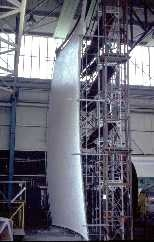The painting ‘Panorama Mesdag’ gives an impression of the fishing village Scheveningen at the end of the 19th century. Hendrik Willem Mesdag of the Haagse School painted it around 1880 with his team.
Earlier research had shown that the cotton cloth had only a quarter of its original strength. There were several hundred cracks on the underside and the suspension. Due to the size of the painting (height: 14.5 meters, length: 120 meters) the restoration had to be carried out on site.
The poor state of the exhibition facilities (over 100 years affected by light, moisture, temperature and its own weight) combined with heavy rains in 1983 ultimately called for a large-scale restoration project.
The restoration consisted of:
- Lining of the complete canvas with a nylon supporting tissue;
- New structure, supporting only the nylon lining.
Computer calculations were done to check stress state and shape of the canvas. Environmental tests were done for durability of the paint and the adhesive bond. The nylon strips were applied like wallpaper and in intervals. With each step the adhesive was heat-cured while a vacuum frame provided pressure.
Thanks to the calculations and tests in advance, the restoration of the canvas could be done in four months and the reinforced canvas will be able to work again for fifty years. The original concave shape of the canvas has also been retained.



